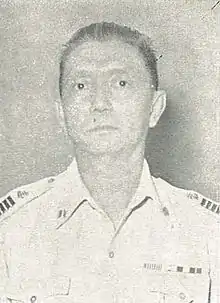John Lie (Indonesian Navy officer)
Jahja Daniel Dharma, BMP, also known as John Lie Tjeng Tjoan (Chinese: 李約翰; pinyin: Lǐ yuēhàn; 11 March 1911 – 28 August 1988), a National Hero of Indonesia, was one of the first high-ranking navy commanders during the Indonesian National Revolution.[1][2]
John Lie Tjeng Tjoan 李約翰 | |
|---|---|
 Lie in 1960 | |
| Birth name | Lie Tjeng Tjoan 李約翰 |
| Born | 11 March 1911 Manado, Dutch East Indies (now Indonesia) |
| Died | 28 August 1988 (aged 77) Jakarta, Indonesia |
| Buried | |
| Allegiance | |
| Service/ | Indonesian Navy |
| Years of service | 1945–1966 |
| Rank | Admiral |
| Awards | National Hero of Indonesia (2009) |
Early life and career
He was born in Manado, Sulawesi (then known as Celebes), Dutch East Indies, on 9 March 1911 to Lie Kae Tae and Oei Tjeng Nie Nio. He started his navy career as a ship-navigator on a Dutch merchant vessel, He joined the Kesatuan Rakyat Indonesia Sulawesi (KRIS), a local militia group in Celebes during the Indonesian War of Independence The marine division of this group became later a part of the Indonesian Navy. Initially, he was stationed in the naval harbour of Cilacap, Java. Within a few months, he managed to clear this harbour from mines, placed by the Imperial Japanese Navy against an eventual Allied naval invasion. For his services, he was promoted to "mayor laut" (lieutenant commander).
Life as a smuggler
In 1947, he was assigned the duty of escorting boats smuggling products to Singapore to be sold for financing the Indonesian independence war. One of his first duties was to escort a convoy of small boats that was carrying 800 tons of rubber to the Chief Representative of the Republic of Indonesia in Singapore, Utoyo Ramelan. During these revolutionary years the Dutch government imposed a naval blockade around Singapore to stop illegal activities by Indonesians. Commander John Lie's duties were to penetrate this blockade and smuggle rubber and other products in exchange for weapons. The weapons were then handed over to the Indonesian revolutionary troops in Sumatra and among others also to the Regent of Riau, an Indonesian ruler during the Dutch colonial time.[3]
Their efforts were not always easy. The boats used for the smuggling were small coastal transport boats (sampan) and not designed for the high seas. Their group had to avoid the better equipped Dutch patrol boats and also the ocean waves. John Lie used for his operations a speedboat named the Outlaw. Once while he was smuggling 18 drums of palm oil, he was captured by British customs. In the Singapore court, however, he was found not guilty and released as he had not violated any British laws. During another incident, while transporting semi-automatic weapons from Johor to Sumatra, he was stopped by a Dutch patrol boat. John Lie informed them that his ship was stranded and couldn't move. Two gunners, probably from the Moluccas, were already aiming their weapons at the Outlaw, but the patrol boat commander didn't issue the shoot command. They just left the Outlaw in the middle of the sea without helping or investigating. After this incident and after handing over the weapons to the Regent Usman Effendi and battalion commander Abusamah, the crew received an official letter from the revolutionary government of Indonesia stating that Outlaw was now part of the Indonesian naval fleet and was designated the official navy-name PPB 58 LB. A week later, John Lie returns to Port Swettenham in Malaya to establish a naval base. This base was used to supply the struggling revolutionary government troops with fuel, gasoline, food, weapons, and other needs to maintain the independence of Indonesia.
Later life, death, and legacy
In early 1950, while in Bangkok, he was called for duty to Surabaya by the Indonesian Navy Chief of Staff Admiral Subiyakto and assigned the command of a corvette, R.I. Rajawali. In the following period he commanded his crew in the fight against the Republic of the South Moluccas (RMS) Maluku and Revolutionary Government of the Republic of Indonesia (PRRI) rebellions.[4] He retired from the navy on December 1966 with the rank of rear admiral. In 1967 he changed his name from John Lie to Jahja Daniel Dharma.[5]
He died after a stroke on 27 August 1988 and was buried in the national heroes cemetery, Kalibata Jakarta.[6] For his services and contributions to the country, he was posthumously awarded with the Bintang Mahaputera Utama by President Suharto on 10 November 1995.
_at_sea_in_August_2015.JPG.webp)
On 10 November 2009 (Indonesia Heroes' Day), for his services to the country before and after independence, Jahja Daniel Dharma was posthumously awarded the Bintang Mahaputra Adipradana and named an Indonesia National Hero by President Susilo Bambang Yudhoyono on behalf of the nation.[7]
A corvette of the Indonesian Navy has been named after him by the Indonesian Government as part of TNI AL in 2014 along with KRI Bung Tomo and KRI Usman Harun.[8]
References
- Asvi Warman Adam (2009). Membongkar Manipulasi Sejarah [Uncovering the Manipulation of History] (in Indonesian). Jakarta: Kompas Penerbit Buku. ISBN 9789797094041.
- Adam, Asvi Warman (31 January 2003). "Pahlawan Nasional Etnis Tionghoa". Kompas (in Indonesian). Archived from the original on 19 February 2003. Retrieved 26 February 2010.
- Rowan, Roy (26 September 1949). "Guns—and Bibles—are Smuggled to Indonesia". Life. 27 (13). pp. 49–52.
- Sudrajat, Arif Arianto. "John Lie, Dari Penyelundup Menjadi Laksamana". detik.com. Retrieved 25 February 2014.
- Sudrajat, Arif Arianto. "John Lie, Dari Penyelundup Menjadi Laksamana". detik.com. Retrieved 25 February 2014.
- Sudrajat, Arif Arianto. "John Lie, Dari Penyelundup Menjadi Laksamana". detik.com. Retrieved 25 February 2014.
- Maulia, Erwida (10 November 2009). "Hero awards given to three noted figures". The Jakarta Post. Retrieved 16 November 2009.
- Sudrajat, Arif Arianto. "John Lie, Dari Penyelundup Menjadi Laksamana". detik.com. Retrieved 25 February 2014.
